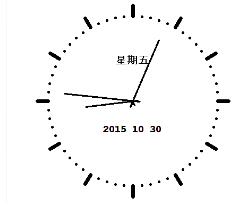溫馨提示×
您好,登錄后才能下訂單哦!
點擊 登錄注冊 即表示同意《億速云用戶服務條款》
您好,登錄后才能下訂單哦!
語言:Python
IDE:Python.IDE
1.編寫時鐘程序,要求根據時間動態更新

2.代碼思路
需求:5個Turtle對象, 1個繪制外表盤+3個模擬表上針+1個輸出文字
Step1:建立Turtle對象并初始化
Step2:靜態表盤繪制
Step3:根據時鐘更新表針位置與時間信息
基本庫:Turtle、datetime
3.代碼段
from turtle import *
from datetime import *
def Skip(step):
penup()
forward(step)
pendown()
def mkHand(name, length):
#注冊Turtle形狀,建立表針Turtle
reset()
Skip(-length*0.1)
begin_poly()
forward(length*1.1)
end_poly()
handForm = get_poly()
#注冊Turtle形狀命令register_shape(name,shape=None)
register_shape(name, handForm)
def Init():
global secHand, minHand, hurHand, printer
mode("logo")# 重置Turtle指向北
#建立三個表針Turtle并初始化
#第二個參數為長度
mkHand("secHand", 125)
mkHand("minHand", 130)
mkHand("hurHand", 90)
secHand = Turtle()
secHand.shape("secHand")
minHand = Turtle()
minHand.shape("minHand")
hurHand = Turtle()
hurHand.shape("hurHand")
for hand in secHand, minHand, hurHand:
hand.shapesize(1, 1, 3)
hand.speed(0)
#建立輸出文字Turtle
printer = Turtle()
printer.hideturtle()
printer.penup()
def SetupClock(radius):
#建立表的外框
reset()
pensize(7)
for i in range(60):
Skip(radius)
if i % 5 == 0:
forward(20)
Skip(-radius-20)
else:
dot(5)
Skip(-radius)
right(6)
def Week(t):
week = ["星期一", "星期二", "星期三",
"星期四", "星期五", "星期六", "星期日"]
return week[t.weekday()]
def Date(t):
y = t.year
m = t.month
d = t.day
return "%s %d %d" % (y, m, d)
def Tick():
#繪制表針的動態顯示
#當前時間
t = datetime.today()
second = t.second + t.microsecond*0.000001
minute = t.minute + second/60.0
hour = t.hour + minute/60.0
secHand.setheading(6*second)
minHand.setheading(6*minute)
hurHand.setheading(30*hour)
#介入Tracer函數以控制刷新速度
tracer(False)
printer.forward(65)
printer.write(Week(t), align="center",
font=("Courier", 14, "bold"))
printer.back(130)
printer.write(Date(t), align="center",
font=("Courier", 14, "bold"))
printer.home()
tracer(True)
ontimer(Tick, 100)#100ms后繼續調用tick
def main():
tracer(False)
Init()
SetupClock(160)
tracer(True)
Tick()
mainloop()
if __name__ == "__main__":
main()
補充:
Python實現時鐘
1.小時鐘獲取當前時間并用打印在Console上
2.上代碼
import time,sys,os
while(1):
t = time.strftime('%H:%M:%S',time.localtime(time.time()))
sys.stdout.write(t+'\b'*10)
sys.stdout.flush()
time.sleep(0.1)
os.system('cls')
3.解釋
第一步:導入time,sys,os模塊
第二部:實現無限循環
第三步:實現格式化輸出,具體的詳細使用方法,參見:這里
第四部:重定向到Console上
第五步:刷新
第六步:間隔0.1執行一次
第七步:清屏
免責聲明:本站發布的內容(圖片、視頻和文字)以原創、轉載和分享為主,文章觀點不代表本網站立場,如果涉及侵權請聯系站長郵箱:is@yisu.com進行舉報,并提供相關證據,一經查實,將立刻刪除涉嫌侵權內容。